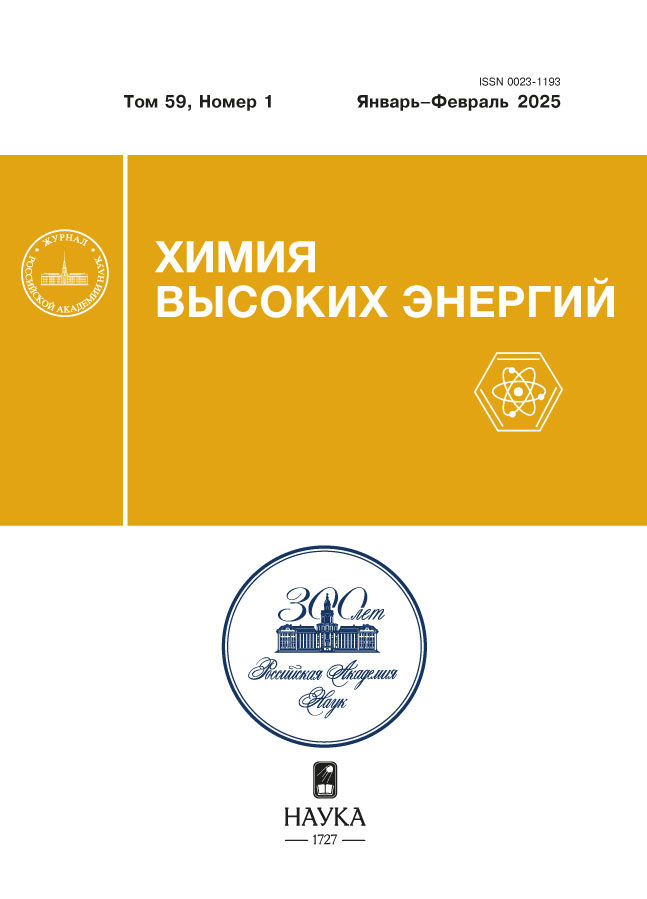Effect of solvents on optical properties and dynamics of exciton states in quantum dots CdZnS/ZnS doped with Mn2+
- Authors: Vasin A.A.1,2, Dobryakov A.L.1,2, Kostrov A.N.1,2, Koroznikova E.E.1, Gostev F.E.1,2, Shelaev I.V.1,2, Antonova O.Y.2, Kochev S.Y.3, Nadtochenko V.A.1,2
-
Affiliations:
- Moscow Institute of Physics and Technology
- N.N. Semenov Federal Research Center for Chemical Physics of the RAS
- A.N. Nesmeyanov Institute of Organoelement Compounds of the RAS
- Issue: Vol 59, No 1 (2025)
- Pages: 3-11
- Section: PHOTONICS
- URL: https://permmedjournal.ru/0023-1193/article/view/684663
- DOI: https://doi.org/10.31857/S0023119325010011
- EDN: https://elibrary.ru/SQNAUB
- ID: 684663
Cite item
Abstract
The dynamics of differential absorption spectra of Mn2+ : Zn0.48Cd0.52S/ZnS quantum dots (QDs) after excitation with a femtosecond (fs) pulse of 360 nm in aprotonic nonpolar cyclohexane and polar propylene carbonate solvents in comparison with the protonic polar solvent water has been studied by femtosecond laser spectroscopy method. The absorption and luminescence spectra of QDs in water revealed bands related to trapped states. The fading band related to the edge exciton of QD attenuates significantly faster in water than in aprotonic solvents, which suggests rapid electron transfer from the 1Se level to trap states in competition with electron transfer to manganese. Apparently, the competition of these processes is the reason for the decrease in the quantum yield of manganese luminescence in Mn2+ : Zn0.48Cd0.52S/ZnS when passing from aprotonic solvents to water.
Full Text
About the authors
A. A. Vasin
Moscow Institute of Physics and Technology; N.N. Semenov Federal Research Center for Chemical Physics of the RAS
Author for correspondence.
Email: a2vasin@yandex.ru
Russian Federation, Dolgoprudny; Moscow
A. L. Dobryakov
Moscow Institute of Physics and Technology; N.N. Semenov Federal Research Center for Chemical Physics of the RAS
Email: a2vasin@yandex.ru
Russian Federation, Dolgoprudny; Moscow
A. N. Kostrov
Moscow Institute of Physics and Technology; N.N. Semenov Federal Research Center for Chemical Physics of the RAS
Email: a2vasin@yandex.ru
Russian Federation, Dolgoprudny; Moscow
E. E. Koroznikova
Moscow Institute of Physics and Technology
Email: a2vasin@yandex.ru
Russian Federation, Dolgoprudny
F. E. Gostev
Moscow Institute of Physics and Technology; N.N. Semenov Federal Research Center for Chemical Physics of the RAS
Email: a2vasin@yandex.ru
Russian Federation, Dolgoprudny; Moscow
I. V. Shelaev
Moscow Institute of Physics and Technology; N.N. Semenov Federal Research Center for Chemical Physics of the RAS
Email: a2vasin@yandex.ru
Russian Federation, Dolgoprudny; Moscow
O. Yu. Antonova
N.N. Semenov Federal Research Center for Chemical Physics of the RAS
Email: a2vasin@yandex.ru
Russian Federation, Moscow
S. Yu. Kochev
A.N. Nesmeyanov Institute of Organoelement Compounds of the RAS
Email: a2vasin@yandex.ru
Russian Federation, Moscow
V. A. Nadtochenko
Moscow Institute of Physics and Technology; N.N. Semenov Federal Research Center for Chemical Physics of the RAS
Email: a2vasin@yandex.ru
Russian Federation, Dolgoprudny; Moscow
References
- Kamat P.V. // J. Phys. Chem. C. Am. Chem. Soc. 2008. V. 112. № 48. P. 18737–18753.
- Sun P. et al. // Chem. Eng. J. 2023. V. 458. P. 141399.
- Rtimi S., Kiwi J., Nadtochenko V. // Curr. Opin. Chem. Eng. 2021. V. 34. P. 100731.
- Martynenko I.V. et al. // J. Mater. Chem. B. Royal Soc. Chem. 2017. V. 5. № 33. P. 6701–6727.
- Cherepanov D. et al. // Nanomaterials. MDPI. 2021. V. 11. № 11. P. 3007.
- Nadtochenko V. et al. // Chem. Phys. Lett. North-Holland. 2020. V. 743. P. 137160.
- Pandey A., Sarma D. // Z. Anorg. Allg. Chem. 2016. V. 642. № 23. P. 1331–1339.
- Wang C.W., Orrison C., Son D.H. // Bull. Korean Chem. Soc. 2022. V. 43. № 4. P. 492–500.
- Yu W.W. et al. // Biochem. Biophys. Res. Commun. 2006. V. 348. № 3. P. 781–786.
- Spirin M.G., Brichkin S.B., Razumov V.F. // High Energy Chem. 2015. V. 49. № 6. P. 426–432.
- Cui S.C. et al. // J. Phys. Chem. C. Am. Chem. Soc. 2010. V. 114. № 2. P. 1217–1225.
- Gostev F.E. et al. // High Energy Chem. 2018. V. 52. № 6. P. 508–509.
- Gostev F.E. et al. // High Energy Chem. 2018. V. 52. № 6. P. 492–497.
- du Fossé I. et al. // J. Phys. Chem. C. Am. Chem. Soc. 2021. V. 125. № 43. P. 23968–23975.
- Moon H. et al. // Adv. Mater. 2019. V. 31. № 34. P. 1804294.
- Nadtochenko V. et al. // J. Photochem. Photobiol. A Chem. 2022. V. 429. P. 113946.
- Archer D.G., Wang P. // J. Phys. Chem. Ref. Data. 1990. V. 19. № 2. P. 371–411.
- Simeral L., Amey R.L. // J. Phys. Chem. Am. Chem. Soc. 1970. V. 74. № 7. P. 1443–1446.
- Barthel J., Feuerlein F. // J. Sol. Chem. 1984. V. 13. № 6. P. 393–417.
- Hassan G.E. et al. // Opt. Mater. (Amst). North-Holland. 1996. V. 5. № 4. P. 327–332.
- Kabachii Y.A. et al. // Mendeleev Commun. 2021. V. 31. № 3. P. 315–318.
- Pradeep K.R., Viswanatha R. // APL Mater. 2020. V. 8. № 2. P. 20901.
- Pradhan N., Peng X. // J. Am. Chem. Soc. 2007. V. 129. № 11. P. 3339–3347.
- Klimov V.I. et al. // Phys. Rev. B. Am. Phys. Soc. 1999. V. 60. № 19. P. 13740.
- Pechstedt K. et al. // J. Phys. Chem. C. Am. Chem. Soc. 2010. V. 114. № 28. P. 12069–12077.
- Sethi R. et al. // Chem. Phys. Lett. North-Holland. 2010. V. 495. № 1–3. P. 63–68.
- de Jesus J.P.A., Jimenez M.Z., La Porta F. de A. // Comput. Mater. Sci. 2021. V. 188. P. 110147.
- Osman M.A., Abd-Elrahim A.G., Othman A.A. // J. Alloys Comp. 2017. V. 722. P. 344–357.
- Wang M. et al. // Chem. Cent. J. Bio. Med Central. 2011. V. 5. № 1. P. 1–10.
- Wang M. et al. // RSC Adv. Royal Soc. Chem. 2015. V. 5. № 106. P. 87496–87503.
Supplementary files















